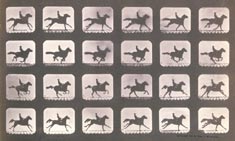|
It is the artist who is truthful and photography which lies, for in reality time does not stop.
—Auguste Rodin
Eadweard J. Muybridge recognized that time itself could become an element of every photograph. He pushed this idea to its extreme by using a camera to take sequences of photographs that recreated the movement of an animal or a person. Muybridge's chief contribution was to the theoretical underpinnings of photography, specifically, the understanding—through purely visual language—that the value of a sequence of photographs could be greater than that of any single image. Muybridge thus paved the way for sequential photographs of all types, including motion pictures. Soon after these studies, the Eastman Dry Plate Company (know today as Kodak) developed flexible roll film, which made motion-picture cameras possible.
Backed by the entrepreneur Leland Stanford (American, 1824–1893), Muybridge used a bank of 24 twin-lens cameras to make exhaustive studies of different species in motion. The works were collected in the monumental publication Animal Locomotion (1887), which contains 781 plates. These images proved that a galloping horse has all four feet off the ground at once, forever changing the way artists represented the horse in motion.
View a brief biography and other works by this artist in the Getty online collections.
Related Bookstore item:
 |
 |

